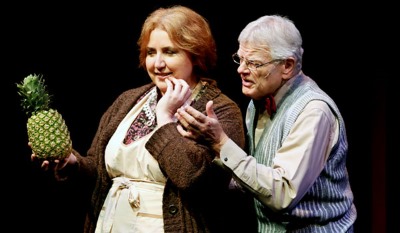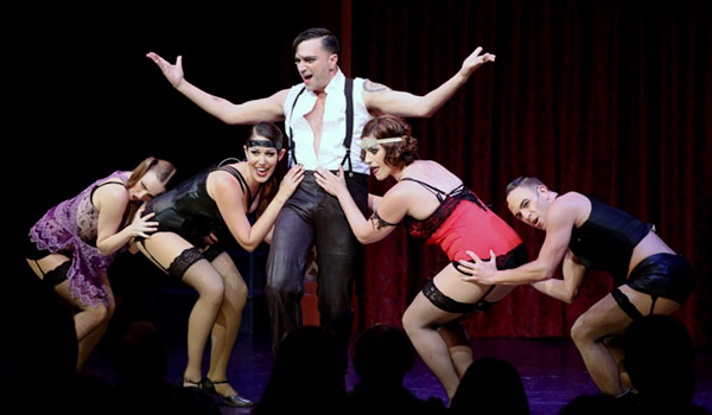Oregon Cabaret Theatre (OCT) is a small (compared to the three Oregon Shakespeare Festival (OSF) theaters nearby, Medford’s Craterian Theatre and even the slightly larger Camelot Theatre down the road in Talent) 140 seat dinner theater in Ashland, in a converted church around the corner from OSF. It has presented 141 theatrical shows in 30 years since the theater opened after completion of the conversion of what had been Ashland’s First Baptist Church in August 1986. To be brutally honest, many of those shows for much of that time, while still quite worthy, were probably not the best tickets in the competitive Southern Oregon theater market. After all, OSF productions have won Tony awards and drawn top tier actors and crew from around the world, the Craterian has the advantage of hosting top line national touring companies, and the Camelot has managed to secure unrivaled financial backing enabling it to construct a state of the art theater building and employ all the latest bells and whistles in its productions. Poor little OCT, always trying harder, but often landing at the back of the pack. So it gives me great pleasure to say that the current production being offered by the Oregon Cabaret Theatre, the classic Kander and Ebbs musical Cabaret, is a complete triumph, an all around winner, as good a theater experience, if not better, than any other show on stage in Southern Oregon this season.
The original production of “Cabaret”, directed by Harold Prince, opened on Broadway in 1966, was a runaway hit, which ran for 1,165 performances and won 8 Tony Awards including Best Musical, Best Original Score, two Best Performance Awards, Best Choreography, Best Scenic Design, Best Costume Design, and Best Direction. It hatched a 1968 National Tour, and a 1972 hit film (representing highlights for the careers of leading actress Liza Minelli and actor Joel Grey). It has spawned countless subsequent productions including several award winning West End productions, at least three award winning Broadway revivals, and numerous international, regional and school productions.

Boarding house owner Fraulein Schneider (Tamara Marston) accepting a fresh pineapple from Jewish German fruit vendor and suitor, Herr Schultz (John Lambie) in Oregon Cabaret Theater’s production of “Cabaret”.
The show is set in and around the decadent Kit Kat Klub in 1931 Berlin as the Nazis are rising to power. The club, where people escape from the disappointments of their lives by immersing themselves in sin and decadence, serves as a metaphor for the menacing political developments which unfolded in late Weimar Germany, as those begin to puncture the escapism of the time (here, pursued by the club’s inhabitants) and to impact everyone’s lives. Leading the tour through the Club and the political changes is the Club’s Emcee (i.e., the Master of Ceremonies), who as narrator, ringleader, and provocateur, is depicted as exhibiting ambiguous sexual proclivities and given a boatload of attention grabbing deviant scenes and much of the politically/philosophically loaded dialogue. There are two parallel primary story lines woven through the plot. The first is the story following the evolution and devolution of the relationship between a young Cabaret performer, Sally Bowles, and a visiting young American writer, Cliff Bradshaw. Of course, their relationship is strained by the harsh political changes of the time, but also by what we today might see as issues of women’s liberation and independence, though that lens wasn’t as well perfected by the writers or the audiences when the play was launched in 1966. The second is the story of a doomed romance between a German boarding house owner, Fraulein Schneider, and a German Jewish fruit vendor, Herr Schultz, at a time of growing persecution and threats to the Jewish population.
The Emcee and the other principals are surrounded by a bevy of seductive, beguiling, provocative Kit Kat Girls, who help illustrate the stories and advance the plot. And of course, there has to be a black hat, Ernst, the closet Nazi who becomes more outspoken as the times become more receptive to that tune. I’ll avoid any more spoilers and if you’re interested in knowing more about the plot or how the story develops, let you see the show and be appropriately awed, surprised or satisfied, as it unfolds.

Kit Kat Club singer Sally Bowles (Jillian Van Niel) belts out a song in Oregon Cabaret Theater’s production of “Cabaret”.
Yes, DO see this show, and now I’ll turn attention to the distinctives of this production – why its such a good theater experience. OCT did just about everything right in putting this production together. It is really well cast – all the performers deliver excellent performances – the singing is in all cases superlative – there are no weak links there; the dancing is also excellent by all the participating performers, and the acting is uniformly good too. Several of the cast really stand out and deserve special recognition, starting with Galloway Stevens as the Emcee. His performance is energetic, inspired, entrancing, magnetic and attention grabbing – everything that the role calls for, and then some. One of the great advantages of OCT’s dinner theater is that the tables and the audience are up close and more intimate with the performers than is possible in the larger theaters. Mr. Galloway takes full advantage of the proximity of the audience, interacting in a direct “in-your-face” way with audience members including even some occasional physical contact with audience members. Jillian Van Niel as Sally Bowles has a superb voice and really delivers full throated memorable renditions of her songs (especially the title number, “Cabaret”), in addition to very successfully conveying the high spirits of her character.
The best acting on the stage was displayed by consummate performer, Tamara Marston, as Fraulein Schneider. To say she never strikes a false note is a major understatement. She just inhabits the role so believably, you’d think she’s that same character off stage (trust me, she’s NOT). I really don’t want to overlook anyone in this cast, as their performances were all up to snuff: Paul Garcia as Cliff, John Lambie as Herr Schultz, and Matt Brown as Ernst. The Kit Kat Girls also rendered uniformly superior performances: Leah Kolb as Kost, Sierra Wells as Lulu, Kerry Lambert was a hoot as a cross-dressing Bobby, and I would be remiss if I didn’t acknowledge Layli Kayhani for a truly memorable turn as Helga: she displayed a full palette of facial expressions that unfailingly depicted the range of emotions appropriate to every moment of every scene plus a million watt smile when that was called for – if you needed any clue to decipher the prevailing emotion in any scene, all you had to do was glance at Helga’s face.
And the acting was just the tip of the iceberg, of the superlatives incorporated in this show. The choreography was a treat – numbers like “Two Ladies” and “Money” were lively, well-coordinated and memorable – kudos to choreographers Valerie Rachelle and Michael Jenkinson. The stage lighting was also well done – very creative and very effective in enhancing the performances, such as the excellent use of changing spotlights to highlight the characters in “Maybe This Time” – the fine work of lighting designer Craig Hudson. Although it’s a small stage, the two story set was very effective and successfully transformable to the Kit Kat Club, Cliff’s apartment, Herr Schultz’s fruit store, a railroad car, and more – good set design also by Craig Hudson. I’ve already remarked at how entrancing the Emcee was and how beguiling were the Kit Kat Girls – some of that gets credited to the wonderful costumes produced by costume designer Kerri Lea Robbins. And I cannot overlook the musicians either – only three musicians comprised the Kit Kat Band instead of the 19 found in some larger productions: Jordan Richardson (also the music director) on keyboard, Tom Freeman supplying the percussion, and Dennis Freese on reeds. But the music was excellent throughout, in accompanying the singers, moving the story along and striking the mood. There were even some places where the musicians and their performances were a positive highlight to the show- for instance I made a note that the saxophone sizzled during the number, “Maybe This Time” – well done Mr. Freese.
Performances of Cabaret continue through August 30 at the Oregon Cabaret Theatre, every day except Tuesdays and July 4, with matinees at 1 pm on Sundays, and evening performances at 8 pm on other days, at 241 Hargadine Street, Ashland, OR 97520. Tickets can be ordered by visiting the box office, calling the box office at 541-488-2902, or online at http://bit.ly/1dA4iJ0.
Oregon Cabaret Theatre provides the following content advisory regarding its production of Cabaret: “While Cabaret does not contain any profanity, nudity, or strong violence, it does have adult themes and strong sexual content. Were it a movie, it would likely be rated PG-13.”
As noted at the outset, Oregon Cabaret Theatre is a dinner theater. You CAN, but do not have to, enjoy dinner as part of your Cabaret theater experience. Dinner is available before evening performances and requires that you arrive and be seated earlier (between 6:30 pm and 7 pm) than if simply attending the 8 pm performance. You must request dinner reservations in advance, from the box office, at the phone number above. The menu, which includes appetizers, entrees and desserts, is available to view online at http://bit.ly/1GQCh7e. There’s also a fairly good wine menu. I’m not a food critic, and not often asked for opinions on that topic, but for what it’s worth, I enjoyed a very nice Prawn Cocktail appetizer and was very pleased with a Pan Seared Halibut entrée, while my accomplice positively raved about a tomato bisque soup on the occasion of my visit to review the show.
Featured image above: Emcee (Galloway Stevens) surrounded by Kit Kat Girls (l-r) Lulu (Sierra Wells), Helga (Layli Kayhani), Kost (Leah Kolb) and Bobby (Kerry Lambert) in Oregon Cabaret Theater’s production of “Cabaret”.

 Lee Greene was born & raised in a NJ family where the only religion worshipped was classical music, Leonard Bernstein was God, and the radio was constantly on and tuned to classical station WQXR (which is now always on in his Jacksonville home thanks to the miracle of the Internet). Growing up in the New York City metropolitan area and later while residing and practicing law in NYC, Lee attended oodles of Broadway and off-Broadway theater productions, as well as concerts and opera at Lincoln Center, Carnegie Hall and other NYC venues. Lee is now a retired attorney, runs a computer support business, and has served on the boards of Rogue Opera & Siskiyou Violins. Lee also writes Performing Arts reviews published on the website,
Lee Greene was born & raised in a NJ family where the only religion worshipped was classical music, Leonard Bernstein was God, and the radio was constantly on and tuned to classical station WQXR (which is now always on in his Jacksonville home thanks to the miracle of the Internet). Growing up in the New York City metropolitan area and later while residing and practicing law in NYC, Lee attended oodles of Broadway and off-Broadway theater productions, as well as concerts and opera at Lincoln Center, Carnegie Hall and other NYC venues. Lee is now a retired attorney, runs a computer support business, and has served on the boards of Rogue Opera & Siskiyou Violins. Lee also writes Performing Arts reviews published on the website,